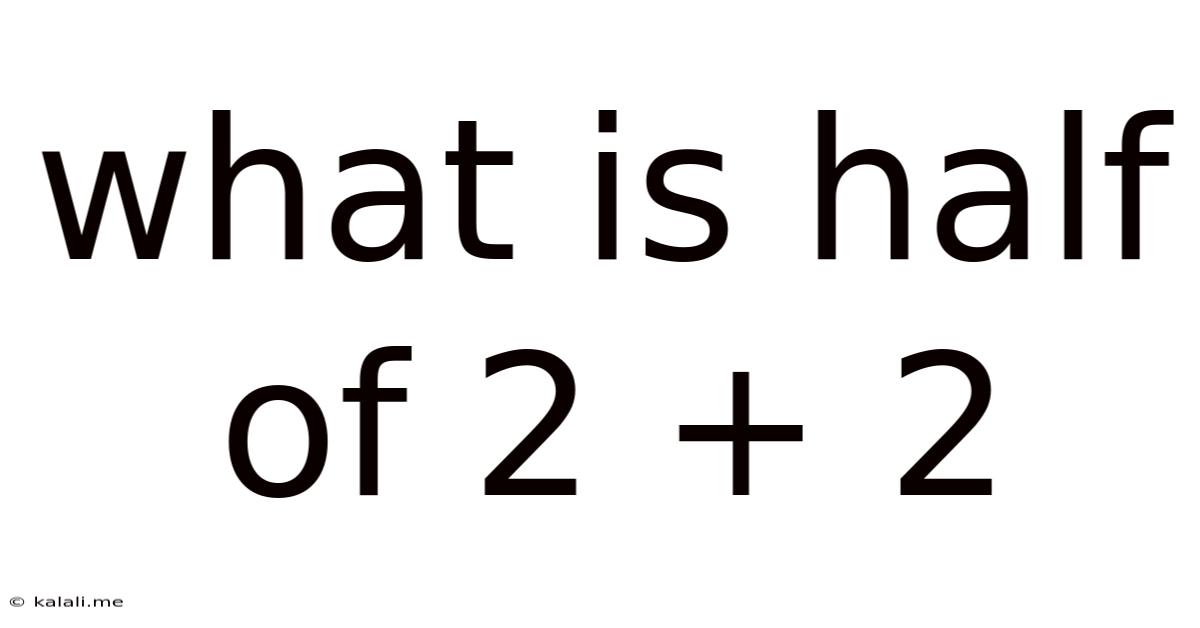What Is Half Of 2 + 2
Kalali
Jul 13, 2025 · 4 min read

Table of Contents
What is Half of 2 + 2? A Deep Dive into Simple Arithmetic and its Implications
This seemingly simple question, "What is half of 2 + 2?", offers a surprising opportunity to explore fundamental principles of mathematics, the importance of order of operations (PEMDAS/BODMAS), and even touch upon the broader implications of mathematical precision in various fields. This article will dissect the problem, offering a clear solution and expanding on the underlying concepts to provide a comprehensive understanding. It's more than just a simple calculation; it's a gateway to understanding mathematical literacy.
Understanding the Problem: Order of Operations
The key to solving "half of 2 + 2" lies in understanding the order of operations, often remembered by the acronyms PEMDAS (Parentheses, Exponents, Multiplication and Division, Addition and Subtraction) or BODMAS (Brackets, Orders, Division and Multiplication, Addition and Subtraction). These mnemonics dictate the sequence in which mathematical operations should be performed. Without adhering to this order, we risk arriving at incorrect answers.
In our equation, we have both multiplication (implied by "half of") and addition. According to PEMDAS/BODMAS, multiplication and division take precedence over addition and subtraction. Therefore, we must first calculate "half of 2" before adding 2.
Step-by-Step Solution
-
Half of 2: "Half of" implies multiplication by 1/2 or division by 2. Half of 2 is 2 ÷ 2 = 1.
-
Addition: Now we substitute the result from step 1 into the original equation: 1 + 2.
-
Final Answer: 1 + 2 = 3. Therefore, the answer to "What is half of 2 + 2?" is 3.
Beyond the Calculation: The Importance of Precision
While this specific problem is straightforward, the principles involved are crucial in various contexts. Consider the implications of neglecting order of operations in more complex scenarios:
-
Engineering and Physics: In fields like engineering and physics, precise calculations are paramount. Incorrectly applying the order of operations could lead to flawed designs, inaccurate predictions, and potentially catastrophic consequences. Imagine the implications of a miscalculation in structural engineering or aerospace design. The difference between 3 and a different result could be the difference between success and failure.
-
Finance and Accounting: In finance and accounting, accuracy is essential. Misinterpreting mathematical expressions could lead to incorrect financial statements, erroneous tax calculations, and significant financial losses. Proper application of order of operations is crucial for maintaining financial integrity.
-
Computer Programming: Computer programming relies heavily on precise mathematical operations. Incorrect order of operations in a program's code can lead to unexpected results, program crashes, or even security vulnerabilities. Programmers must be meticulous in their adherence to these principles.
-
Data Analysis and Statistics: Data analysis and statistics heavily rely on accurate calculations. Mistakes in mathematical operations can lead to flawed interpretations of data, incorrect conclusions, and misguided decisions.
-
Everyday Life: Even in everyday life, understanding order of operations can be valuable. For example, when calculating the total cost of items with discounts or taxes, the correct order of operations is crucial to arrive at the accurate final price.
Addressing Potential Misinterpretations
One common mistake is interpreting "half of 2 + 2" as (2 + 2) / 2. This approach is incorrect because it doesn't adhere to the established order of operations. The phrase "half of 2 + 2" specifically implies that "half of" applies only to the number 2, not the entire expression 2 + 2.
Expanding on Mathematical Concepts
This simple problem can also serve as a springboard to explore more advanced mathematical concepts:
-
Algebra: The problem can be expressed algebraically as (1/2 * 2) + 2 = x. Solving for x reinforces the understanding of order of operations and algebraic manipulation.
-
Fractions and Decimals: The problem implicitly involves fractions (1/2). It can be further expanded to explore calculations involving different types of numbers and their interconversion.
-
Real-World Applications: Numerous real-world scenarios can be modeled using similar arithmetic expressions. Understanding the principles involved allows for accurate problem-solving in various practical contexts.
Conclusion: The Power of Simple Arithmetic
The seemingly trivial question, "What is half of 2 + 2?", reveals the importance of understanding basic mathematical principles. The correct application of the order of operations is not merely a matter of following rules; it's fundamental to accuracy and precision in various aspects of life, from everyday calculations to complex scientific and engineering endeavors. This problem serves as a reminder of the power of seemingly simple arithmetic and its far-reaching implications. The answer, 3, is only the starting point of a deeper exploration into the fascinating world of mathematics. Mastering these fundamental principles is crucial for building a strong foundation in mathematical literacy and problem-solving skills. It’s a testament to the fact that even the simplest mathematical questions can unlock a wealth of knowledge and understanding.
Latest Posts
Latest Posts
-
How Many Times Does 2 Go Into 48
Jul 13, 2025
-
12 405 As A Fraction In Simplest Form
Jul 13, 2025
-
How Many Feet Is A Tenth Of A Mile
Jul 13, 2025
-
How Many Months In Half A Year
Jul 13, 2025
-
What Time Does Church Start On Sunday
Jul 13, 2025
Related Post
Thank you for visiting our website which covers about What Is Half Of 2 + 2 . We hope the information provided has been useful to you. Feel free to contact us if you have any questions or need further assistance. See you next time and don't miss to bookmark.